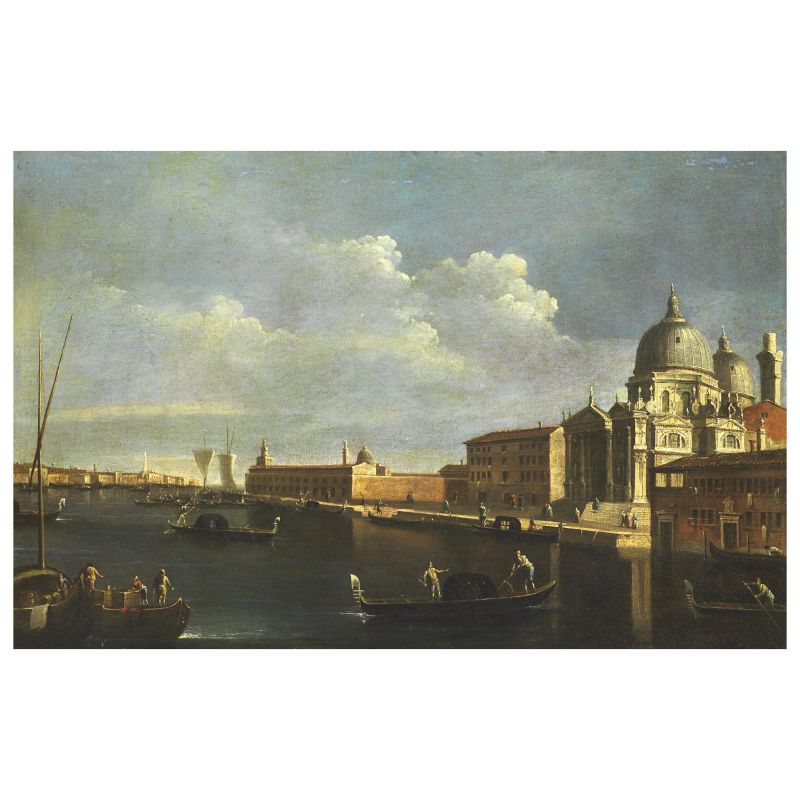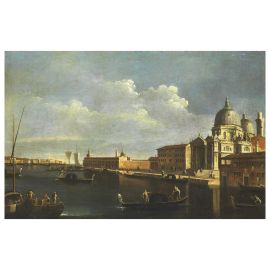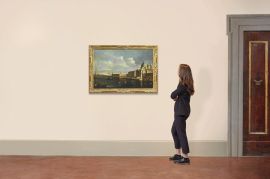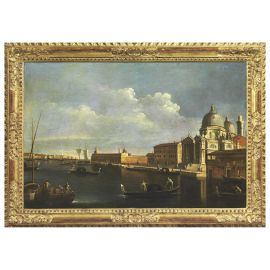Francesco Tironi
(attivo a Venezia nell'ultimo quarto del sec. XVIII)
BASILICA DELLA SALUTE A VENEZIA
olio su tela, cm 63,5x95
Francesco Tironi
(active in Venice in the last quarter of the 18th century)
BASILICA OF HEALTH IN VENICE
oil on canvas, cm 63,5x95
Il dipinto è corredato da un parere scritto di Charles Beddington datato 16 febbraio 2023 che pubblichiamo integralmente:
"This view of the easternmost stretch of the Grand Canal before it opens onto the Bacino di San Marco is one of the most celebrated in the repertoire of Venetian view painting in the eighteenth century, the composition is borrowed, with variations, from an etching by Luca Carlevarijs, one of the plates in his Le fabriche, e vedute di Venetia disegnate, poste in prospettiva, et intagliate published in 1703. Supported by no fewer than 1,156,627 wooden piles, the church of Santa Maria della Salute is the preeminent Baroque church in Venice. The masterpiece of Baldassarre Longhena (1598-1682), it was begun following a Senate decree of 22 October 1630, in the hope that its construction would result in the deliverance of the city from the plague, a recurrent problem to which it was particularly susceptible, and which killed more than 46.000 people in Venice sixteen months in 1630-31 (hence the church's name, 'Salute' meaning 'healt' or 'salvation'). Longhena was fortunate to live just long enough to the church's completion in 1681. The site, only separated from the Dogana di mare (Maritime Customs House) by the Seminario Patriarcale, was chosen partly because of its proximity to San MArco, San giorno Maggiore and the Redentore. Standing close to the point where the Grand Canal enters the Bacino di San Marco, its towering domes are the focal point for any view down the last stretch of the Gran Canal, as well as for many vistas from the Bacino.
This painting is, in my opinion, a characteristic work by Francesco Tironi.
Surprisingly little is know about the artist life; in fact all that we know for certain is that in 1806 he had 'died too young a few years ago'. He has been identified with a priest of that name who died on 28 February 1797 at the age of about 52, but that was hardly 'young' by Venetian standards of the day and there is no evidence that thhis preist was also an artist. Another candidate is a Francesco Spiridione Tironi (1757-1791, but his stated business was running a shop which sold account books and white paper.
Work by Tironi is rather more abundant. A set of engravings by Antonio Sandi (1733-1817) entitled Twenty-Four Views of Islands in the Venetian Lagoon, published by Ludovico Furlanetto in Venice at some point after 1799, follow drawings by Tironi, many of which survive, and which are his best known works. Of a very fine quality, and a number of them formerly thought to be by Canaletto, many of these are now in the great drawings collections of the world: the Albertina, Vienna (6), the Robert Lehman Collection in the Metropolitan Museum of Art, New York (2), the Whitworth Art Gallery, Manchester, and the National Gallery of Art, Washington D. C. One is in the Former Collection fo Franz Koenigs, and six others are in private collections. These have permitted the secure attribution of a number of other compositions of the artist's own invention. Examples are in the Victoria and Albert Museum, London (6), the Pierpont Morgan Library, New York (2), the National Gallery of Art, Washington, and elsewhere.
Attributions of paintings have in the past proved more complicated, Hermann Voss crediting him in publications of 1928 and 1966 with some of the early views by Francesco Guardi, while in more recent decades he has sometimes been idetified as the author of work by the rather older 'Master of the Langmatt Foundation Views'. A number of canvases signed with the initials 'F T' are now known, including San Cristoforo, San Michele and Murano from the Sacca della Misericordia (Karlsruhe, Staatliche Kusthalle) and a pair showing The isola di San Giorgio Maggiore and The Molot looking West, which are both signed with initials, and corresponds with interesting variations, with one of the compositions engraved by Santi (in this case the drawing in untraced).
From the secure works a considerable group of paintings in the same distinctive style can be established, including views of the mainland such as The Palazzo Recanati-Zucconi Vendramin on the Brenta Canal, and a capriccio of the Doge's Palace and other prominent Venetian buidings set on a canal. Tironi, as he can now be understood, is an original and interesting figure. While his drawing style and compositional structure recall Canaletto's methods to the point that it seems probable that he worked in Canaletto's studio, his mannered figures are closer to Francesco Guardi's mature types. His palette, dominated by greens and browns and sombre often almost to the point of monochromy, finds parallels in much of the late work of both painters. The main problem is that, while the drawings are mostly of a consistently high quality, the standard of the very large number of paintings in Tironi's style varies widely. The only monograph on the artist includes many paintings at the lower end of the quality scale. The new understanding of the artist's capabilities has, however, resulted in recent years in exceptional prices for securely attributable works such as the pairs of Venetian views (of similar size to this) sold at Christie's, London, in 2021 and 2014, and The Grand Canal, looking East from the Pescheria towards the Rialto sold at Sotheby's, London, in 2010.
A smaller version (58x75 cm.), with different boats but arranged in a similar manner, forms part of a set of four Venetian views in a private collection.
A painting of a similar composition sold at Hampel, Munich, 8 December 2022, lot 219, as the work of Francesco Tironi, is, in the opinion of the present writer, a crude imitation".






